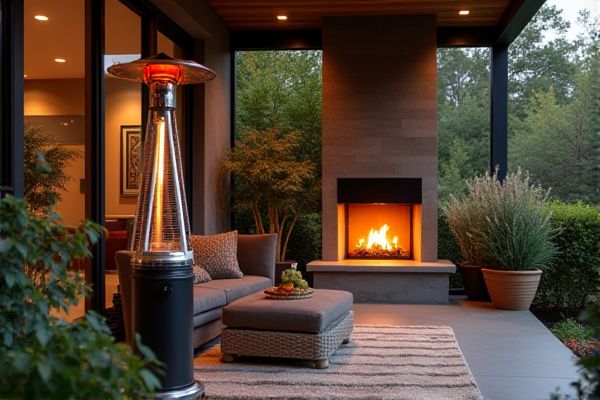
Patio heaters provide consistent, widespread warmth ideal for larger outdoor spaces, while fire columns offer a stylish, compact design that creates a cozy ambiance with concentrated heat. Explore the rest of this article to discover which option best suits your outdoor heating needs and enhances your comfort.
Table of Comparison
| Feature | Patio Heater | Fire Column |
|---|---|---|
| Heat Source | Propane or electric | Gas or ethanol flame |
| Heat Output | Up to 48,000 BTU | Moderate, focused heat |
| Design | Tall, umbrella-style | Sleek, vertical column |
| Portability | Portable but bulky | Lightweight and easy to move |
| Safety | Requires stable base, tip-over protection | Open flame, requires supervision |
| Installation | Minimal setup, plug & play | May require professional installation |
| Ambiance | Functional warmth, limited visual appeal | Strong visual fire element |
| Price Range | $150 - $600 | $300 - $1,200 |
| Best Use | Outdoor heating for gatherings | Decorative heating and ambiance |
Introduction to Patio Heaters and Fire Columns
Patio heaters and fire columns provide outdoor heating solutions with distinct designs and functionalities, enhancing comfort in open-air spaces. Patio heaters typically use propane or electric elements to radiate warmth evenly across patios, while fire columns feature a vertical flame enclosed in glass, combining aesthetics with heat. Both options vary in fuel type, heat output, and style, catering to different outdoor ambiance and heating needs.
Key Features of Patio Heaters
Patio heaters are designed with a tall, freestanding structure that emits radiant heat, making them ideal for outdoor spaces. They often feature adjustable heat settings, durable weather-resistant materials, and fuel options including propane, natural gas, or electric power. Key features include a wide heat distribution area, safety shut-off mechanisms, and easy portability for enhanced user convenience.
Key Features of Fire Columns
Fire columns offer a sleek, vertical design that provides consistent radiant heat for outdoor spaces, making them ideal for modern patios and decks. They typically use propane or natural gas, with adjustable flame settings and safety features such as automatic shut-off sensors. Unlike traditional patio heaters, fire columns often include decorative glass or metal panels that enhance ambiance while maintaining efficient heat distribution.
Heating Efficiency Comparison
Patio heaters typically use propane or natural gas to emit infrared heat, delivering rapid and consistent warmth over a wider area, making them highly efficient for outdoor gatherings. Fire columns, often fueled by natural gas or propane, provide a more concentrated radiant heat with an aesthetic flame feature but generally cover a smaller heating radius. When comparing heating efficiency, patio heaters outperform fire columns in distributing heat evenly and maintaining a stable temperature in open-air environments.
Design and Aesthetic Appeal
Patio heaters typically feature a traditional, utilitarian design with a tall, slender structure that blends seamlessly into various outdoor settings, while fire columns offer a modern, sleek appearance with clean lines and a sculptural element that enhances your outdoor decor. Fire columns often utilize glass and stainless steel materials, creating a minimalist yet striking visual focal point, whereas patio heaters emphasize functionality with protective covers and larger heating surfaces. Choosing between these options depends on whether your priority is classic warmth or contemporary style to elevate your outdoor ambiance.
Installation and Setup Differences
Patio heaters typically require minimal installation, often being portable or simply needing a propane tank hookup or an electrical outlet for setup, making them ideal for quick and flexible use. Fire columns usually demand a more permanent installation, including grounding, secure positioning, and sometimes hardwired gas connections, which may involve professional assistance. The complexity of setup for fire columns contrasts with the straightforward assembly of most patio heaters, influencing the choice depending on desired mobility and installation convenience.
Fuel Types and Operating Costs
Patio heaters commonly use propane or natural gas, offering affordable fuel options with moderate operating costs, while fire columns often run on propane or electricity, which can lead to varying expenses depending on energy prices. Propane patio heaters typically provide longer burn times at a lower cost compared to electric fire columns, which may incur higher electricity bills but offer cleaner operation. Your choice between these depends on balancing fuel availability, cost efficiency, and maintenance preferences.
Safety Considerations
Patio heaters feature built-in safety mechanisms such as automatic shut-off switches and flame failure devices to prevent accidents, making them a reliable choice for outdoor heating. Fire columns, while visually striking, require careful placement away from flammable materials and constant supervision due to open flames and higher heat exposure. Both options demand adherence to manufacturer guidelines and local fire regulations to ensure safe operation in outdoor settings.
Maintenance and Durability
Patio heaters require regular cleaning and occasional gas checks to maintain optimal performance and safety, while fire columns demand consistent removal of ash and debris to prevent clogging and ensure even flame distribution. Fire columns often feature durable materials like stainless steel or tempered glass, offering excellent weather resistance, whereas patio heaters may have more exposed components prone to rust if not properly cared for. Your choice should factor in the ease of maintenance and the long-term durability of each option to ensure a reliable outdoor heating solution.
Which is Best for Your Outdoor Space?
Patio heaters provide consistent, widespread warmth ideal for larger outdoor areas, while fire columns offer a stylish focal point with softer heat suited for intimate settings. Consider the size of your space, heating needs, and aesthetic preferences when choosing between these options. Energy efficiency and fuel type, such as propane or electric, also impact overall performance and maintenance requirements.
 homyna.com
homyna.com